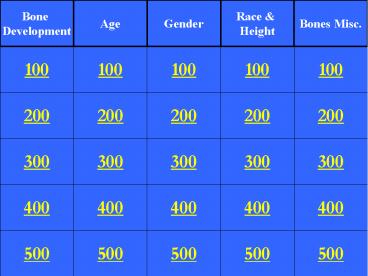Bone - PowerPoint PPT Presentation
Title:
Bone
Description:
Bone Development Age Gender Race & Height Bones Misc. 100 100 100 100 100 200 200 200 200 200 300 300 300 300 300 400 400 400 400 400 500 500 500 500 500 ... – PowerPoint PPT presentation
Number of Views:94
Avg rating:3.0/5.0
Title: Bone
1
Bone Development
Age
Gender
Race Height
Bones Misc.
100
100
100
100
100
200
200
200
200
200
300
300
300
300
300
400
400
400
400
400
500
500
500
500
500
2
What is ossification?
3
The process of bone formation in which
osteoblasts lay down calcium in cartilages
turning these cartilages to bone.
4
Describe osteoblasts and osteoclasts.
5
Osteoblasts bone building cellsOsteoclasts
bone destroying cells
6
How do bones form?
7
- Osteoblasts migrate into the cartilage of an
infants skeleton. - Osteoblasts deposit calcium
- The calcium hardens to form bones.
8
Describe three structures that attach to bone to
help form the skeleton.
9
Ligaments (Join bone to bone) Tendons
(Connect muscle to bone) Cartilage (Cushions
bones at joints)
10
What is an osteobiography?
11
Your life story told through your bones.
12
How many bones does an adult skeleton
have?Approximately how many bones does an infant
skeleton have?
13
Adult 206 (average)Infant 450 (average)
14
What is the epiphyseal plate?
15
A line of cartilage where bone growth occurs.
16
By what age are all the epiphyseal plates and
sutures fused?
17
Age 50
18
Using the chartsEstimate the age of an
individual ifThe clavicle and sternum and
sternum of the shoulder are closed and the
condyles of the leg have joined the shaft.
19
20
20
Using the chartsEstimate the age of an
individual ifThe lambdoidal suture is nearly
closed and all segments of the sacrum are united.
21
25-29
22
Can a skeleton exhibit characteristics of both
genders.What does this mean for a forensic
anthropologist.
23
Skeletons can exhibit characteristics from both
genders (especially older skeletons).This means
that forensic anthropologists should use many
characteristics from many bones to determine
gender.
24
What is the gender of this skull?
25
Male
26
What is the gender of this skull?
27
Female
28
What is the gender of this pelvis?
29
Female
30
What is the gender of this pelvis?
31
Male
32
What are the three races used for forensic
identification?
33
CaucasoidMongoloidNegroid
34
What makes determining race difficult?
35
Many people exhibit characteristics from multiple
races.
36
What type of bones are generally used to
determine height?
37
Long bones, like the femur and humerus
38
Explain why forensic anthropologist can only
estimate height.
39
Environmental factors can affect a persons
height, such as diet, accidents, etc.
40
Using the charts provided for you estimate the
height of an individual with a femur that
measures 40cm in length.
41
About 152 cm
42
What is forensic anthropology?
43
The study of human skeletal remains in a legal
setting.
44
Who were the Romanovs and why did we discuss them
in this unit?
45
The royal family of Russia, they were executed
and forensic anthropology was used to identify
their remains over 80 years after their deaths.
46
What type of DNA evidence can be retrieved from
skeletal remains and why?
47
Mitochondrial DNA because nuclear DNA breaks down
faster.
48
What is facial reconstruction?
49
The rebuilding of facial features from skeletal
remains using clay or computer models.
50
What is the importance of forensic anthropology
today.
51
Identify victims of accidents, mass killings or
brutal crimes. Bring closer to families and
cases.































